 klaus-michael schneider
klaus-michael schneider
Keywords: education |
Links: FOTW homepage | search | disclaimer and copyright | write us | mirrors

Last modified: 2021-05-22 by  klaus-michael schneider
klaus-michael schneider
Keywords: education |
Links: FOTW homepage |
search |
disclaimer and copyright |
write us |
mirrors
![[Flag of Colombia]](../images/c/co.gif) (2:3)
(2:3)  image by Željko Heimer, 20 May 2001
image by Željko Heimer, 20 May 2001
See also:
 image by Ivan Sache, 9 Jan 2004
image by Ivan Sache, 9 Jan 2004
The Escuela was founded in 1944. Its flag is horizontally divided white-green (2:1).
Source: this webpage, located by Dov Gutterman.
Ivan Sache, 9 Jan 2004
Escuela Normal Departamental was established in Ocaña (Norte del Santander
Department) in 1944. The management of the school was transferred on 1 January
1952 to the Sisters of the Presentation, a congregation founded in 1695 by Marie
Poussepin (1653-1744). The school, then directed by Mother María Rosalía,
Superior of Colegio Diocesano, was officially approved by Resolution No. 3,271
of 27 November 1952, as Escuela Normal Nacional para Señoritas de Ocaña. Escuela
Normal Superior de Ocaña was eventually established by Decree No. 1,373 of 10
October 1997.
Source:: institute website
Ivan Sache, 07 Dec 2014
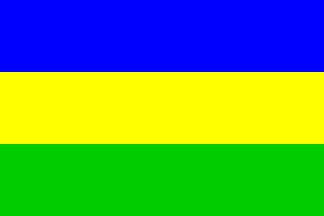 image by Ivan Sache, 8 January 2009
image by Ivan Sache, 8 January 2009
"Colegio de Occidente", located in Tuluá,
Department of Valle, was recognized on 8 September 1995 by the
Department of Valle (Decree No. 209). The merging of
the institute with "Centro de Desarrollo Comunal",
"Juana de Arco", "Fray Martín de Porres",
"El Jardín" and "Marino Gilibert" formed the
"Institución Educative Occidente" on 5 September 2002
(Decree No. 1847).
The flag, as shown graphically and described on the website of the
institute, is horizontally divided blue-yellow-green.
Blue represents life, waters and heavens.
Yellow represents light, wealth and knowledge.
Green represents hope and commitment to work.
In May 2004, a competition was called for the design of the
symbols (anthem, flag, coat of arms, motto and animal) of the new
institute.
The jury considered 11 flag proposals in October 2004 and
proclaimed the results on 12 November 2004.
The new symbols were officially presented on 11 April 2005 in a
public ceremony.
Ivan Sache, 8 Jan 2009
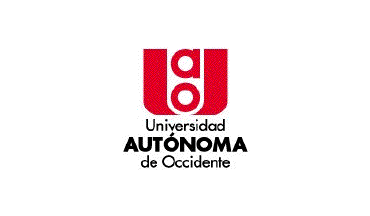 image by Ivan Sache, 08 Nov 2014
Flag to be used indoors:
image by Ivan Sache, 08 Nov 2014
Flag to be used indoors: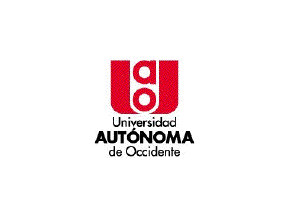 image by Ivan Sache, 08 Nov 2014
image by Ivan Sache, 08 Nov 2014
Universidad Autónoma de Occidente UAO) is a private university located in
Cali (Valle Department). UAO hires 650 professors educating some 9,000 students,
scattered among the five Faculties of Engineering, Social Communication,
Economical and Administrative Sciences, Environment Sciences, and Humanities.
UAO was established by Resolution No. 618 of 20 February 1970 and recognized as
an academic institution by Resolution No. 2,766 of 13 November 2003.
The symbols of UAO are prescribed in the User's Guide of Corporative Identity,
first released on 10 October 2007 and last revised on 20 September 2013. The
flag of UAO is prescribed in § 8.1 as white with the university's logo in the
middle. Flags for outdoors use are 3.5 m x 6 m in size, while flags for indoors
use are 0.90 m x 1.20 m in size. The width of the logo is 1/3 of the flag's
width.
The logo of UAO in today's use was designed in 1978 by Manfred Hirsh, a student
in Industrial Economy at Universidad Tecnológica del Valle. This was the third
logo of the university (§ 1.2). The logo is described in § 2.1 as based on the
initials of the university's name. Letters "A" and "O", for "Autónoma" and
"Occidente", respectively, are surrounded by two rectangles, whose bottom is
rounded-off to form letter "U", for "Universidad". Beneath, the name of the
university is written on three lines:
- top line: "Universidad", lower case, Futura Media font;
- middle line: "Autónoma", upper case, Futura Black font;
- bottom line: "de Occidente"; lower case, Futura Medium font.
Precise construction details of the logo are given in § 3.1.
- height of "Universidad" and "de Occidente": x
- height of "Autónoma": 1.2 x
- size of the red and white emblem: 5.4 x on 5.8 x
- height of letters "a" and "o": 2.4 x
- space between letters "a" and "o" and the red "u"; 0.3 x
- space between the emblem and "Universidad": 0.3 x
- space between "Universidad" and "Autónoma": 0.5 x
- space between "Autónoma" and "de Occidente": 0.3 x
The shade of red is prescribed as Pantone 1795 C, CMYK (%) 0-100-100-0 (§ 3.6),
and Websafe palette FF0000 (§ 3.7).
Source::
http://www.uao.edu.co/sites/default/files/DC-1.8-MU1-Identidad-Corporativa-SEPT-20-DE-2013.pdf
- User's Guide of Corporative Identity
Ivan Sache, 08 Nov 2014
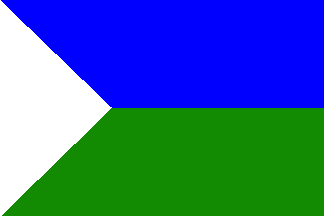 image by Ivan Sache, 13 May 2021
image by Ivan Sache, 13 May 2021
Liceo Octavio Paz was established in 1998 in Bosa (Bogota) by Mónica Torres
Suárez and Samuel Albarracín Beltrán, as Liceo Infantil Pepito Guillo. The
institute was officially recognized by Municipal Decree No. 1,946 of 22 June
1999. The institute is named for the Mexican poet and diplomat Octavio Paz
(1914-1998), awarded the Cervantes Prize in 1981 and the Nobel Prize in
Literature in 1990. Paz was member of the editorial board of the Colombian
review "Mito" from 1955 to 1962.
The flag of the institute is horizontally divided blue-green with a white
triangle placed along the hoist. Blue is a symbol of loyalty, trust, knowledge,
responsibility, and intelligence. Green is a symbol of natural environment,
growth, freshness, stability, and safety. White is a symbol of purity, kindness,
and child innocence.
Source: photo from institute's website
Ivan Sache, 31 July 2014
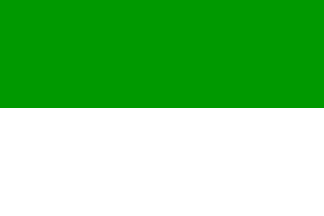 image by Ivan Sache, 23 October 2014
image by Ivan Sache, 23 October 2014
Escuela Normal Superior Oiba (Santander Department) was established by
Municipal Agreement No. 1 of 30 October 1960, as Colegio Emperatriz Arenas, soon
renamed Colegio Femenino Emperatriz Arenas de la Santísima Trinidad in November
1960, Escuela Normal de Señoritas in January 1961, and Escuela Normal
Departamental de Señoritas in December 1961. The institute was renamed Escuela
Normal Mixta de Oiba by Resolution No. 743 of 16 May 1985, and, eventually,
Escuela Superior Oiba in 1999.
The flag of the institute is presented in the institute's Etiquette Guidebook as
horizontally divided green-white. Green represents the student's life stage,
when they have to mature through knowledge and integral education, defending the
values that will allow them to create promising fruit for the country. White is
a symbol of purity, knowledge, representing all the children submitted to the
institute's education and care. White is also a symbol of honesty, virtue,
honour, peace, humility, tranquillity, and harmony to be supplied in the
institute, as well as sincerity in all acts, providing a pedagogic atmosphere
conducive to united work.
Source: institute website
Ivan Sache, 23 Octr 2014
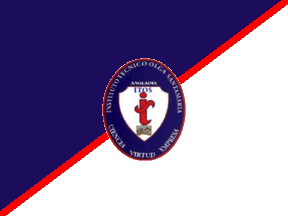 image by Ivan Sache, 17 Mar 2019
image by Ivan Sache, 17 Mar 2019
IED Instituto Técnico Olga Santamaría (ITOS) was established in September
1953 in Anolaima (Cundinamarca Department) by the historian and benefactor
Reverend Father Jaime Hincapié Santamaría, as Escuela Holgar.
The flag of
ITOS is prescribed in Article 4.2. of the Manual de Convivencia as composed of
two equal triangular stripes, the one blue and the other white, separated by a
red line. On the companion photo, the school's coat of arms is placed in the
center of the flag.
The coat of arms of ITOS is prescribed in Article
4.1. of the Manual de Convivencia.
The coat of arms of the school uses the
colors that have been identifying it all along its history. The shield is oval
with, on the border, the school's name at the top and the school's motto at the
bottom, "CIENCIA" [Science], meaning wisdom, knowledge, lore, understanding,
comprehension and self-control, "VIRTUD" [Virtue], meaning honesty, dignity,
integrity, valor, equity, life rectitude and justice, "EMPRESA" (Enterprise]
meaning grouping, association, company, society, community, project management,
production and social management. Inside is placed the acronym "ITOS", with an
open book as the symbol of press and a an owl representing wisdom, knowledge,
innovation, organization and company establishment.
https://fr.calameo.com/read/00046323468db8101188c, Manuel de Convivencia
Originally designed by Director Alberto Nieto Cabezas, the coat of arms was
modified in 2001 by the teachers Aminta Amaya, Gloria Reyes and Ronni Édgar
Martínez; they also changed the original motto, "Vida, Amor y Conicimiento"
(Life, Love and Knowledge) to the present-day one.
ITOS website
Ivan Sache, 17 Mar 2019
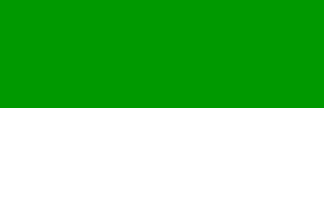 image by Ivan Sache, 07 Dec 2014
image by Ivan Sache, 07 Dec 2014
Institucion Educativa Diversificada Oriental is located in Santo Tomás
(Atlántico Department).
The flag of the institute is horizontally divided green-white.
Source: institute's blog -
Ivan Sache, 07 Dec 2014
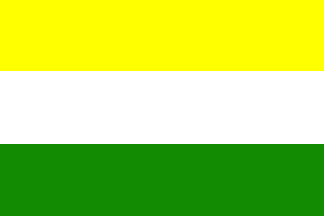 image by Ivan Sache, 13 May 2021
image by Ivan Sache, 13 May 2021
Universidad Católica de Oriente (UCO) was established in Rionegro (Antioquia
Department) by Decree No. 103 of 11 February 1982, signed by His Grace Alfonso
Uribe Jaramillo (1914-1993), Bishop of Sonsón-Rionegro (1968-1993). UCO was
recognized as an academic institution by Resolution of the Ministry of National
Education No. 3,278 of 25 June 1993.
The flag of UCO is horizontally divided yellow-white-green. The colours were
taken from the flags of Rionegro (white), Antioquia (white and green), Colombia
(yellow), and the Holy See (yellow and white).
Yellow is a symbol of knowledge, white is a symbol of peace, and green is a
symbol of hope in youth and progress.
Sources: university website and university facebook
Ivan Sache, 20 Oct 2014
I wonder if we'll ever set up that complete list of colour meanings. I don't think I've seen yellow for knowledge before.
Peter Hans van den Muijzenberg, 11 Nov 2014